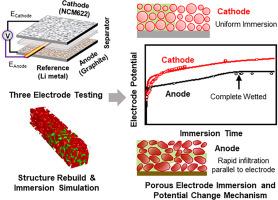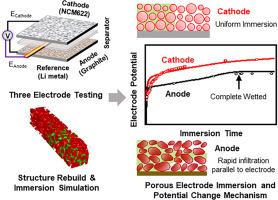了解高密度电池电极中的电解质渗透机制:多模式方法
IF 20.2
1区 材料科学
Q1 CHEMISTRY, PHYSICAL
引用次数: 0
摘要
随着对电池能量密度要求的提高,电池的尺寸和电极的压实密度都在不断提高,这对实现电解质完全渗透到多孔电极结构中提出了巨大的挑战。这种渗透过程的效果直接关系到电池的性能。因此,对控制电解质渗透的基本科学原理的细致理解对于先进电池的设计和生产至关重要。本研究综合了实时电位监测、3D x射线显微镜计算机断层扫描(XRM-CT)来精确重建电极结构,以及计算模拟来全面了解渗透机制。研究结果表明,电解质的渗透过程经历了初始接触、大孔渗透、微孔浸没和完全润湿四个不同的阶段。阴极颗粒的均匀分布和伴随的广泛分散的无取向孔隙有利于逐渐均匀的电解液浸泡。相反,阳极的片状颗粒和定向孔导致平行于电极平面的更快的渗透,导致不同电极之间电导率的可变变化。这些观察结果表明,电极内颗粒和孔隙的取向和分布在决定其润湿行为以及整体电池性能方面起着关键作用。这种综合研究方法为改进电极设计和提高锂离子电池的制造效率提供了关键的见解。本文章由计算机程序翻译,如有差异,请以英文原文为准。


Understanding electrolyte infiltration mechanisms in high-density battery electrodes: A multimodal approach
As the demand for higher battery energy density intensifies, the dimensions of cells and the compaction density of electrodes are on the rise, presenting a formidable challenge in achieving complete electrolyte infiltration into the porous electrode structures. The efficacy of this infiltration process is directly linked to battery performance. Therefore, a nuanced understanding of the underlying scientific principles governing electrolyte infiltration is vital for the design and production of advanced batteries. This study synthesizes real-time potential monitoring, 3D X-ray microscopy computed tomography (XRM-CT) for accurate electrode structure reconstruction, and computational simulations to offer a holistic insight into the infiltration mechanisms. The findings reveal that the electrolyte infiltration progresses through four distinct stages: initial contact, macroporous penetration, microporous immersion, and complete wetting. The uniform distribution of cathode particles and the accompanying widely dispersed, unoriented pores facilitate a gradual and uniform electrolyte immersion. In contrast, the anode's flake-like particles and oriented pores lead to a more rapid infiltration parallel to the electrode plane, resulting in variable changes in conductivity across different electrodes. These observations indicate that the orientation and distribution of particles and pores within the electrodes play a pivotal role in determining their wetting behavior and, consequently, the overall battery performance. This integrative research approach yields critical insights for refining electrode design and enhancing manufacturing efficiency in lithium-ion batteries.
求助全文
通过发布文献求助,成功后即可免费获取论文全文。
去求助
来源期刊

Energy Storage Materials
Materials Science-General Materials Science
CiteScore
33.00
自引率
5.90%
发文量
652
审稿时长
27 days
期刊介绍:
Energy Storage Materials is a global interdisciplinary journal dedicated to sharing scientific and technological advancements in materials and devices for advanced energy storage and related energy conversion, such as in metal-O2 batteries. The journal features comprehensive research articles, including full papers and short communications, as well as authoritative feature articles and reviews by leading experts in the field.
Energy Storage Materials covers a wide range of topics, including the synthesis, fabrication, structure, properties, performance, and technological applications of energy storage materials. Additionally, the journal explores strategies, policies, and developments in the field of energy storage materials and devices for sustainable energy.
Published papers are selected based on their scientific and technological significance, their ability to provide valuable new knowledge, and their relevance to the international research community.
 求助内容:
求助内容: 应助结果提醒方式:
应助结果提醒方式:


